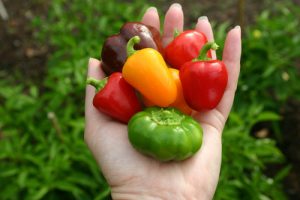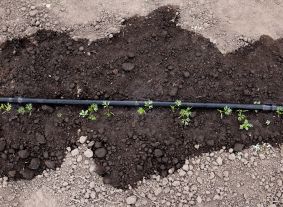Growing Sweet Peppers
Views: 20994

The National Garden Bureau has chosen the sweet pepper as its Vegetable Crop of 2015.
It’s about time! Hot peppers have been such the rage in recent years as folks try their hand at growing their own salsa and such, so it’s nice to see that the sweeter and milder side of peppers is gaining some recognition.
When people think of sweet peppers they often picture bell peppers—those blocky shaped peppers that we see as sometimes the only sweet pepper options in the grocery store. But there are many types of peppers than just bells.
There are the elongated “banana” shapes, the blocky-but-long shapes, the round shapes and many others, too. They also come in a rainbow of colors; red and green for sure, but also purple, pink, orange, yellow and even an off-white. If you’re looking for a wide range in color and variety for your garden, you can find it all with peppers.
How to Peppers From Seed
If you’re growing peppers from seed, sow them indoors about eight weeks before your region’s last frost date. Because they tend to suffer from transplant shock (peppers suffer physically if their roots are pried from soil and inserted into new soil), sow the seeds in biodegradable, plantable pots so no root prying is necessary.
Growing Pepper Plants
I’ve only ever bought my pepper plants from garden centers, mainly so I can plant a range of different types and colors of peppers.
Find a spot in your garden that hasn’t recently been planted with peppers or anything in the pepper family—tomatoes, eggplant, or other peppers.
Make sure this location gets plenty of sun and has soil that is loose and composty. You could even try growing pepper plants in containers on porches or patios, or even squeezed into a corner of the garden. Because the plant has a nice growth habit and pretty, glossy leaves, peppers are beautiful and bountiful.
Fertilize with your favorite vegetable garden fertilizer every two weeks up until the plants start to flower. Your peppers will keep flowering and producing up until the first frost.
Growing Problems
Be sure to plant the peppers the recommended distance apart. Otherwise, the closeness will prevent air circulation, promote disease, and limit pollen distribution.
I’ve also had issues with pepper maggots, whose adult form lays eggs onto barely visible fruit and whose larvae grow inside the fruit as it develops. When you cut open your pepper, you find this ugly and very disappointing interloper. This is just another reason to plant your peppers in a different location from the year before—so the insects have a harder time finding their host plants.
Another solution is to cover the planting area in landscape or garden fabric and “punch” your pepper plant into the ground through a small hole. The fabric will prevent them from crawling up and finding the pepper plants, or it will hold them off for a little while at least. I’m trying this technique this year. My fingers will be crossed.
When to Harvest Peppers
Peppers can be harvested whenever you feel they are the right size for you. If you have a fun, colorful variety, see if you can hold off the harvest until the fruit turns that color. Early harvest triggers the plant to produce more fruit, but a later harvest will give you a fruit that has a milder and sweeter flavor. Your choice.
Thank you to the National Garden Bureau for the use of this awesome photo of the Sweet Petite Color Blend.
Meet Ellen Wells
When you’re raised on a farm, you can’t help but know a thing or two about gardening. Ellen Wells is our expert on edible gardening.…
Ellen's Recent Posts

Asparagus






